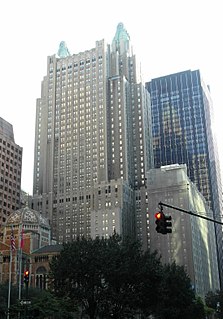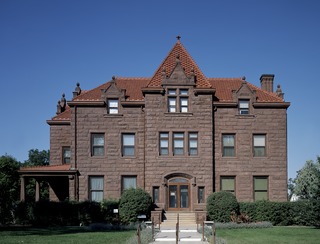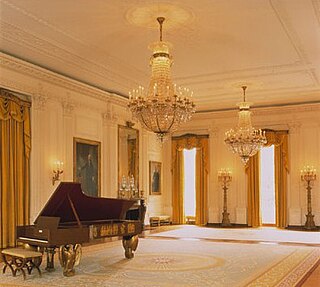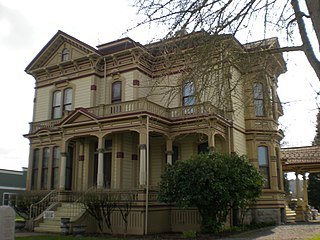
The Waldorf Hotel (later known as the Milner Hotel and the Earle Hotel) was a hotel building in Fargo, North Dakota, US with entrances on Seventh and Front streets. It opened on April 1, 1899 and was demolished in 1951. [1]

The Waldorf Hotel (later known as the Milner Hotel and the Earle Hotel) was a hotel building in Fargo, North Dakota, US with entrances on Seventh and Front streets. It opened on April 1, 1899 and was demolished in 1951. [1]
It was built on the site of the old Sherman house, diagonally across Front street from the new Northern Pacific depot. It cost upwards of US$75,000, and the furniture $19,000. The capital was furnished largely by O. J. DeLendrecie, a Fargo merchant, who owned and operated the largest department store west of the Twin Cities.
The hotel's proprietor was R. R. Wise. It was leased and furnished by Samuel Mathews and George E. Nichols. Hancock Brothers of Fargo were the architects. The contractors were Stewart Wilson for the basement, and J.H. Bowers for the other parts of the structure.
The heating plant was installed by the Archambo Heating Company, Minneapolis. The bricks were furnished by the Twin Cities and the trimmings by the Portage Sandstone Company.
Messrs Ashelman Bros. & Prescott did the decorating with the exception of the dining room ceiling. They also did the paper hanging and painting. Milton Earl Beebe had supervision of the work.
The plumbing was done by the Fargo Plumbing Company, and was one of the largest jobs ever done in the city. An entire carload of bath tubs was imported by them for the contract.
The Mantel & Tile Company of Saint Paul, Minnesota, undertook the marble and tile work. [2]
The exterior was 140 by 150 feet (43 m × 46 m), four stories and basement. It measured 61.13 feet (18.63 m) in height. [1] The basement is of stone. The walls are pink pressed brick trimmed with Portland entry stone. There is an iron balcony of 70 feet (21 m) around the front. The Waldorf had 108 rooms besides 15 rooms for help. There were 40 suites with baths and 15 rooms with hot and cold water. There were return bells in every room and telephone connection with the office from several of the leading suites. The elevator was run by electricity making it at the time the only hotel in the state that had this feature. The house was heated by steam throughout. The rooms were large. The floor was of mosaic tile, the wainscoting, counter and desk were of white and grey marble. The office measured 75 by 100 feet (23 m × 30 m). The fireplace contained a carved mantel of oak. There were immense plate glass windows. The arches were carved. [2]
The upper floors were reached by a broad staircase of steel and marble, and by an electric elevator. The furniture cost upwards of $19.000; it was of solid mahogany and oak, with a few suites being of bird's-eye maple. There were six parlors en suite. The fourth floor was exclusively for regular boarders, and fitted with closets and other conveniences necessary for home life. The bedsteads on the second floor were of brass, and the floors above were iron with brass trimmings. [2]
The dining room was 40 by 75 feet (12 m × 23 m). It had arched windows draped with curtains. The ceiling was tinted and frescoed in floral designs. At one end of the dining room, there were two alcoves, which were entered through carved arches. The dining room furniture included a sideboard. The china was decorated, and the silver was of the modern design. The room had a maple floor. The kitchen was modern. The laundry and ice house were in the basement. Quarters for the help were housed in an annex. Just off from the office and close to the Seventh street entrance there was a ladies' waiting room which contained a writing desk and an Oriental rug. West of the office was a drug store, 27 by 60 feet (8.2 m × 18.3 m), with an opening into the office, and west of that a jewelry store, 24 by 30 feet (7.3 m × 9.1 m). [2]

The Waldorf Astoria New York is a luxury hotel in Midtown Manhattan in New York City. The structure, at 301 Park Avenue between 49th and 50th streets, is a 47-story 625 ft (191 m) Art Deco landmark designed by architects Schultze and Weaver, which was completed in 1931. The building was the world's tallest hotel from 1931 until 1963, when it was surpassed by Moscow's Hotel Ukraina by 23 feet (7.0 m). An icon of glamour and luxury, the current Waldorf Astoria is one of the world's most prestigious and best known hotels. Waldorf Astoria Hotels and Resorts is a division of Hilton Hotels, and a portfolio of high-end properties around the world now operate under the name, including in New York City. Both the exterior and the interior of the Waldorf Astoria are designated by the New York City Landmarks Preservation Commission as official landmarks.

Biltmore Estate is a historic house museum and tourist attraction in Asheville, North Carolina. Biltmore House, the main residence, is a Châteauesque-style mansion built for George Washington Vanderbilt II between 1889 and 1895 and is the largest privately owned house in the United States, at 178,926 square feet (16,622.8 m2) of floor space. Still owned by George Vanderbilt's descendants, it remains one of the most prominent examples of Gilded Age mansions.

The Mayflower Hotel is a historic hotel in downtown Washington, D.C., located on Connecticut Avenue NW. It is two blocks north of Farragut Square. The hotel is managed by the Autograph Collection Hotels division of Marriott International. The Mayflower is the largest luxury hotel in the District of Columbia, the longest continuously operating hotel in the Washington D.C. area, and a rival of the nearby Willard InterContinental and Hay-Adams Hotels. The Mayflower is known as the "Grande Dame of Washington", the "Hotel of Presidents", and as the city's "Second Best Address" —the latter sobriquet attributed to President Harry S. Truman. However, today it is only a four-star hotel.

The Moss Mansion Historic House Museum is located in Billings, Montana on 914 Division St. It is a red-stoned mansion built in 1903 by Preston Boyd Moss and his wife, Martha Ursula Woodson Moss, (Mattie). Mr. and Mrs. Moss moved to Billings from Paris, Missouri where, "There was more happening at midnight than at noon in Paris Missouri"

The East Room is an event and reception room in the White House, the home of the President of the United States. The East Room is the largest room in the Executive Mansion; it is used for dances, receptions, press conferences, ceremonies, concerts, and banquets. The East Room was one of the last rooms to be finished and decorated, and it has undergone substantial redecoration over the past two centuries. Since 1964, the Committee for the Preservation of the White House has, by executive order, advised the President of the United States and First Lady of the United States on the decor, preservation, and conservation of the East Room and other public rooms at the White House.

The State Dining Room is the larger of two dining rooms on the State Floor of the Executive Residence of the White House, the home of the President of the United States in Washington, D.C. It is used for receptions, luncheons, larger formal dinners, and state dinners for visiting heads of state on state visits. The room seats 140 and measures approximately 48 by 36 feet.

The Roosevelt New Orleans in New Orleans, Louisiana, is a 504-room hotel owned by AVR Realty Company and Dimension Development and managed by Waldorf Astoria Hotels & Resorts. The hotel was originally built by Louis Grunewald, a German immigrant, and opened in 1893 as "The Hotel Grunewald."

The Warkentin House is a house in Newton, Kansas, United States. The home of Bernhard Warkentin and Wilhelmina Eisenmayer Warkentin, it was built between 1886 and 1887. It is listed on the Kansas Register of Historic Places and National Register of Historic Places as a splendid example of the Victorian period in American architecture and furnishings. The Victorian house offers a glimpse into the way the Warkentins lived, with 80 percent of the original furnishings remaining.

The E.W. Marland Mansion is a 43,561 square feet (4,046.9 m2) Mediterranean Revival-style mansion located in Ponca City, Oklahoma, United States. Built by oil baron and philanthropist Ernest Whitworth (E.W.) Marland, as a display of wealth at the peak of the 1920s oil boom, the house is one of the largest residences in the southwestern United States, and is known as the "Palace on the Prairie." It was designated a National Historic Landmark in 1973, and is now a museum open to the public.

La Fetra Mansion located in Summit, New Jersey, United States is a mansion designed and built for industrialist H. A. LaFetra of the Royal Baking Powder Company by Henry Bacon, architect of the Lincoln Memorial in Washington, D.C. This mansion has been the home of industry leaders since 1899.

Villa Cavrois in Croix is a large modernist mansion built in 1932 by French architect Robert Mallet-Stevens for Paul Cavrois, an industrialist from Roubaix active in the textile industry.

Thomas Jefferson Tower, originally the Thomas Jefferson Hotel and then the Cabana Hotel, is a 19-story building on the western side of downtown Birmingham, Alabama. It was completed in 1929 as the 350-room Thomas Jefferson Hotel and is at 1623 2nd Avenue North. It has a tower in its roof intended to be a zeppelin mooring mast.

Hays Hall was a residence hall at Washington & Jefferson College. The architectural work was performed by Frederick J. Osterling and it was named after President George P. Hays. Construction was completed in 1903 and the new "fireproof" building was opened to Washington & Jefferson Academy students. Rooms were arranged in a suite style, with communal bathrooms on each floor, and shower baths on the 5th floor. In 1912, the Academy closed and Hays Hall was used by Washington & Jefferson College students. At various times, Hays Hall housed the bookstore and a dining hall. By 1968, Hays Hall had deteriorated to the point where it no longer able to house students, but the bookstore remained. In 1982, the building was declared a fire hazard and closed for all uses. While various efforts sought to renovate or restore Hays Hall, including a push to have it named a historical landmark, Hays Hall was demolished in 1994.

The La Salle Hotel was a historic hotel that was located on the northwest corner of La Salle Street and Madison Street in the Chicago Loop community area of Chicago, Illinois, United States. It was situated to the southwest of Chicago City Hall and in very close proximity to St. Peter's Church. It was built between 1908 and 1909 by Holabird & Roche, contemporaneously with the Blackstone Hotel designed by Benjamin Marshall in a very similar style and at the time was Chicago's finest hotel.

The Historic Whalehead Club is a large 21,000-square-foot (2,000 m2) home located on a remote tract facing the Currituck Sound in North Carolina, United States. The structure was designed by owners Edward Collings Jr. and Marie Louise Label Knight and contracted by Daniel Peckham between 1922 and 1925. The home remains a prominent examples of Art Nouveau.

The Waldorf–Astoria originated as two hotels, built side-by-side by feuding relatives on Fifth Avenue in Manhattan. Built in 1893 and expanded in 1897, the Waldorf–Astoria was razed in 1929 to make way for construction of the Empire State Building. Its successor, the current Waldorf Astoria New York, was built on Park Avenue in 1931.

Ezra Meeker owned and resided in two homes in Puyallup. The first home of the Meeker family was a cabin on the homestead claim which Meeker purchased from Jerry Stilly. This was a one-room cabin, 8 by 16 feet square on the claim. Meeker added a second room, doubling the size with double fireplace made of float lava rock between them. The Meeker family lived here from 1862 until 1886. The wooden cabin disappeared over time. After the move to the mansion, Meeker donated the cabin site to the city, who created Pioneer Park. Several steel and concrete pillars outline the dimensions of the original cabin. The ivy vine covering the pillars grew over the original cabin. A statue of Ezra Meeker was placed in the park and dedicated during his lifetime.

The Montcalm hotels are a group of luxury hotels in central London, England. The group includes The Montcalm London Marble Arch and The Marble Arch by The Montcalm London, both of which are near Marble Arch, as well as M By Montcalm Shoreditch London Tech City, located in Shoreditch. The Montcalm at The Brewery London City and London City Suites by Montcalm, both of which are located in the City of London, round out the hotel chain. Each of the sites is a five-star hotel. The Montcalm London Marble Arch was acquired by Shaftesbury Hotels in 2008.

Murray Hill Hotel was a hotel situated at 112 Park Avenue in Murray Hill, Manhattan, New York City. Built in 1884, with 600 rooms and two courtyards, it was demolished in 1947. It was part of the Bowman-Biltmore Hotels chain.

Holland House was a New York City hotel located at 274–276 Fifth Avenue at the southwest corner of 30th Street in NoMad, Manhattan, New York City, with a frontage of 250 feet (76 m) on Fifth Avenue. The architects and designers were George Edward Harding and William T. Gooch. A mercantile building by the 1920s, in the present day, it is a loft building.
![]()
Coordinates: 46°52′27.4″N96°47′23.8″W / 46.874278°N 96.789944°W